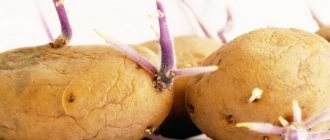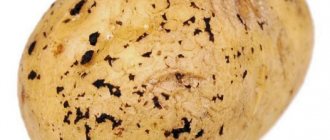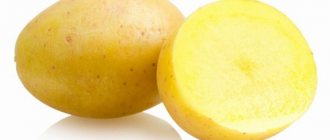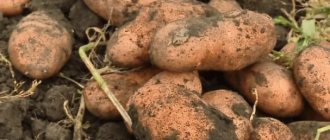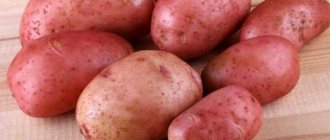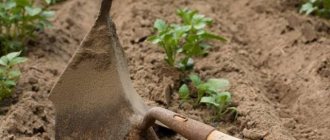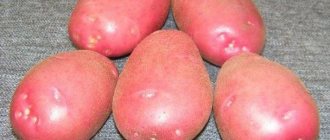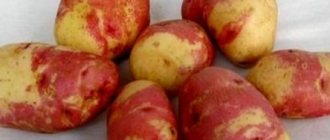Potatoes "Labella": variety description, photo
| Variety name | Labella |
| Maturation period | 70-80 days |
| Starch content | 13-15% |
| Weight of marketable tubers | 78-102 g |
| Number of tubers in a bush | up to 14 |
| Productivity | 176-342 c/ha |
| Consumer qualities | excellent taste, medium cooking |
| Keeping quality | 98% |
| Peel color | red |
| Flesh color | yellow |
| Preferred Growing Regions | North Caucasian |
| Disease resistance | The variety is highly resistant to leaf curl virus, resistant to golden potato cyst nematode, various types of rot and the causative agent of potato cancer. |
| Features of cultivation | resistant to elevated temperatures during the growing season, highly adaptable to climatic conditions and soil types. |
| Originator | Solana GmbH & Co. KG (Germany) |
The main characteristics of the Labella potato variety:
- medium-sized tubers, weighing 78-102 g;
- elongated oval shape, leveled;
- the peel is thin, smooth, reddish;
- ocelli superficial, small, dark red;
- the flesh is pale yellow when cut;
- starch content is below average;
- high content of protein, mineral salts, B vitamins.
The amount of starch in potato tubers of other varieties:
| Variety name | Starch |
| Labella | 13-15% |
| Lady Claire | 12-16% |
| Innovator | up to 15% |
| Bellarosa | 12-16% |
| Riviera | 12-16% |
| Karatop | 11-15% |
| Veneta | 13-15% |
| Gala | 14-16% |
| Zhukovsky early | 10-12% |
| Lorch | 15-20% |
For a more complete description of Labella potatoes, take a look at the photo:
Key points of care
The ripening period depends on various factors: weather conditions and how the vegetable grower cares for the crop. To avoid mistakes, all nuances are taken into account. Labella care measures are standard.
Watering
The bushes are watered during periods of drought, using 10 to 15 liters of water per plant. It is better to water in the evening at the roots. This is necessary so as not to damage the plant, since if you flood the plant in the morning, the sun's rays will leave burns on the leaves.
Fertilizer
Fertilizing plays an important role in growing potatoes. If fertilizers are not applied in time, the plant will not be able to develop normally, but an overabundance will also have a negative impact on the bush.
The best option for fertilizing:
- carry out the first fertilizing during planting (1 tablespoon of the medicine “Solution” or urea per bucket of water);
- perform a second feeding at the beginning of budding (potassium phosphate and ash are diluted in 10 liters of water);
- the third - during the flowering period: it promotes faster formation of potatoes.
Prevention
The Labella variety tolerates late blight epidemics well and rarely suffers from virus damage, but as a preventive measure it is necessary to treat the plant with herbicides.
Every few years the place where the crop is grown is changed. It is good to plant potatoes in areas where legumes or cabbage previously grew. You should not plant root crops in place of peppers or tomatoes.
Characteristic
The Labella variety is zoned for different regions of Russia and is suitable for industrial cultivation. Potatoes tolerate unfavorable weather conditions, tolerate heat and short-term drought .
The yield is good, up to 300 kg are harvested from 1 hundred square meters. The first tubers can be dug up in early summer. Potatoes reach their maximum yield towards the end of the growing season.
And in the table below you can see what the yield and percentage of tuber marketability are for other potato varieties:
| Variety name | Productivity (c/ha) | Marketability of tubers (%) |
| Labella | 176-342 | 98 |
| Limonka | 195-320 | 96 |
| Melody | 180-640 | 95 |
| Margarita | 300-400 | 96 |
| Aladdin | 450-500 | 94 |
| Courage | 160-430 | 91 |
| Beauty | 400-450 | 94 |
| Grenada | 600 | 97 |
| Mistress | 180-380 | 95 |
The Labella potato bush is low, compact, erect, without spreading branches. The leaves are medium-sized, dark green, with slightly wavy edges. Small pink-violet flowers are collected in compact corollas. The root system is well developed. The bush produces up to 14 large potatoes , the amount of non-commercial small potatoes is minimal.
"Labella" is distinguished by its tolerance to the vagaries of the weather and does not require frequent watering . Potatoes prefer light sandy soil. To increase productivity, balanced mineral fertilizers are recommended, which are applied to the soil at the beginning of the season.
The variety is not too demanding to care for, its agricultural technology is simple, this potato is suitable for beginner gardeners.
Potatoes are resistant to many diseases typical of nightshades. It is rarely affected by potato canker, tuber rot and viruses. Not susceptible to late blight epidemics . The variety is young enough, so the tubers do not degenerate. For sowing, you can use the harvest you collected yourself.
Potatoes of the Labella variety have a wonderful taste: quite rich, not watery, slightly sweet . When cutting and cooking, the tubers do not darken. Cookability is average. Potatoes can be fried or boiled and retain their shape well. The tubers can be used to make chips, freeze-dried purees and other ready-made products.
Harvesting
Dry, sunny weather is chosen for harvesting. The bushes are dug up with a pitchfork or a shovel, then the tubers are selected. Each hole of the Labella variety produces up to 16 large potatoes, suitable for processing and storage. There are practically no small things.
The harvest is what you need, see for yourself:
The harvested potatoes are dried for several hours in the sun, then removed for ripening in a dark, dry room for 10 days. The sorted and sorted tubers are stored in a cellar or basement. The harvest is stored well; by spring, 98% of the harvest is preserved.
Origin
The Labella potato variety was bred by German breeders. The creator of the variety is the large company Solana , specializing in modern high-yielding hybrids of various crops.
The variety was included in the Russian State Register in 2011 . Zoned for the Central, Central Black Earth, Volga-Vyatka, North Caucasus, Far Eastern regions.
Recommended for farms and industrial complexes. It is possible to plant in personal yards. The variety is good for sale and processing . Excellent keeping quality; after harvesting, re-sorting is not required.
Read more about storing potatoes, terms and temperatures, and possible problems. And also about how to store root vegetables in winter, on the balcony, in boxes, in the refrigerator and peeled.
Reviews
I have never found potatoes so easy to grow, the care is minimal, and the harvest has been pleasing for the fifth year. I fight Colorado potato by planting plants with a strong smell in the inter-rows and fragrant tobacco around the perimeter of the potato plot. The season before last, the bushes in the neighboring beds were affected by late blight, the German variety survived the harvest and laid all the tubers nearby to dry; this year the disease is already manifesting itself in Labelle. It turns out that I have ruined the planting material, I will be purchasing a new batch of seed tubers.
The potatoes are almost the same size and shape; there are almost no underdeveloped small things in the nests by the time they are fully ripened. I rate the taste 5 points; thanks to the weak starch content, the puree turns out to be thick, but not “sticky” consistency. The variety is still little studied, so far there have been no problems during cultivation, no diseases, and the Colorado potato beetle is a regular guest in beds with nightshades. I don’t use any decoctions or infusions, they need to be used often, and I go to the dacha once every 2 weeks. When the colorado appears, I treat the bushes with Corado or Killer.
All your articles will be on this page.
Advantages and disadvantages
The main advantages of the variety include:
- evenness of root crops, there are no too large or too small tubers;
- low maintenance requirements;
- excellent yield;
- tolerance to high temperatures, drought resistance;
- excellent commercial quality of root crops, potatoes can be grown for sale;
- high taste qualities;
- the harvested crop is well stored and transported;
- resistance to major diseases.
The variety has practically no disadvantages. The only difficulty can be considered susceptibility to frost.
Reviews
Reviews of Labella potatoes are positive. The variety is valued for its pronounced potato taste and aroma, disease resistance and ease of care.
Irina, Moscow: “For a long time I was looking for a variety that tasted like potatoes from my childhood. I saw these pink, smooth tubers with yellow flesh at my neighbor’s dacha and asked me to share. When I tasted the potatoes, I realized: this is what I need. The Labella variety is quite productive and unpretentious in care, easy to grow, and does not suffer from anything. I advise everyone to try growing it on their own plot.”
Vladislav, Stavropol: “I have been growing Labella for several years in a row. The variety is liked for its stable immunity to many diseases. At least in my area the bushes have never gotten sick. The tubers have dark pink skin and yellow flesh. They boil slightly in water and are more suitable for frying and baking.
Galina, Magnitogorsk: “For me, this is the best potato field; I don’t plant anything else besides it. The tubers are smooth, do not suffer from anything, you don’t even need to sort them, the taste is excellent. When cooked, the potatoes do not boil into a paste, but retain their shape.”
Features of cultivation
Preparing the soil for the next sowing begins immediately after harvesting . All tubers are carefully selected from the ground to avoid the risk of infection. Potassium and phosphorus complexes are added to the soil. In the spring, cultivation is carried out, nitrogen-containing fertilizers are applied: ammonium nitrate or urea.
Read more about what to feed potatoes, when and how to apply fertilizers, and how to do it correctly when planting.
For greater productivity, it is recommended to plant not only small things, but also large tubers , cut into several parts. To prevent them from rotting, the procedure is carried out immediately before planting.
Potatoes are planted with row spacing of 70-75 cm. 7-10 days after planting, hilling is carried out with the formation of ridges. The potato field is weeded twice a season and watered 2-3 times. In dry weather, the amount of watering can be increased. In the intervals between plantings, potato plantations should rest. Read about how to grow potatoes without weeding and hilling here.
Phacelia or oilseed radish can be used as green manure. During the growth of the bushes, the most developed and strong specimens can be noted; they will provide seed material for the next year. Mulching will help control weeds.
The Labella variety is resistant to damage . Tubers touched by a hoe or a combine quickly heal the wounds, and the potatoes have an excellent presentation regardless of the harvesting method. For farms and large industrial fields, it is recommended to use harvesters with side digging, which prevent injury to the tubers.
After harvesting, the crop is laid out on furrows to dry. In cloudy weather, drying under a canopy is necessary. Potatoes store well in a cool, dry place and are suitable for sale both after harvest and after several months of storage.
Landing
Tubers are removed from storage 25-30 days before the planned planting. Potatoes weighing 40-65 g are selected. Large material is cut, leaving at least 3-4 eyes on each tuber. Dust the cut areas with ash powder.
Germination lasts up to 3 weeks.
Selected, defect-free material is treated with 1% potassium permanganate, disinfectants Vist, TMTD, Prestige, Acrobat. For stimulation, soak for a couple of hours in the activator:
- Sweat;
- Epin;
- Bioglobin.
Potatoes bear fruit well in different types of soil, but show increased yield in a loose nutrient substrate with a pH in the range of 5.5-5.7. If the soil is sandy, rotted mullein, mineral compounds, and ash are added to it. Peat, sand, and sawdust are poured into heavy loams. To deoxidize the soil, lime, dolomite, and ash are used (added once every 4-5 years).
It is useful to sow green manure crops - phacelia, rye, oats - in a plot with potatoes. After harvesting the early harvest (in mid-summer), the area is sown with cruciferous crops: radish, daikon, turnip, radish, and greens. This allows you to improve the quality of the soil and harvest additional root crops in the fall.
When plowing in autumn, humus, superphosphate, and potassium salt are added to the plot. In spring, 7 kg of ash per 100 m2 is added to the ground. Plant in holes at intervals of 35-40 cm. At the same time as the vegetable, it is useful to plant beans (a natural protector against the Colorado pest).
Good predecessors are:
- pumpkin;
- greenery;
- radish;
- turnip;
- cabbage;
- onion;
- zucchini
The vegetable is planted in the beds from the 3rd decade of April, the first half of May. The heating of the soil is taken into account - the temperature at a depth of 8 cm should be no lower than 10 degrees. Despite the increased drought resistance, the variety does not tolerate soil frosts. At -2-4 degrees, young seedlings may freeze.
Planting is done in holes to a depth of 7-8 cm. Follow a step of 40 cm. Leave a distance between rows of 70 cm.
Diseases and pests
The peculiarity of the variety is its high resistance to typical diseases. Potatoes tolerate late blight epidemics without problems and rarely suffer from viral diseases: leaf curl, tobacco mosaic. To prevent plantings, they are treated once with herbicides. In case of infection, it is recommended to mark the affected bushes; they are not suitable for collecting seed.
Tubers of affected plants are dug up as early as possible, the tops are cut off and burned.
Immunity
The variety has good immunity. Labella is protected from diseases such as tuberous rot, potato cancer, mosaic, leaf curl and late blight. But nevertheless, in order not to expose Labella to the risk of contracting some disease, it is advisable to follow a number of rules:
- before planting, it is advisable to treat the seed material with special preparations;
- It is advisable to immediately remove infected bushes from the site and burn them;
- you need to collect all the tubers, leaving nothing in the ground. Leftover root vegetables can attract large numbers of insects.

